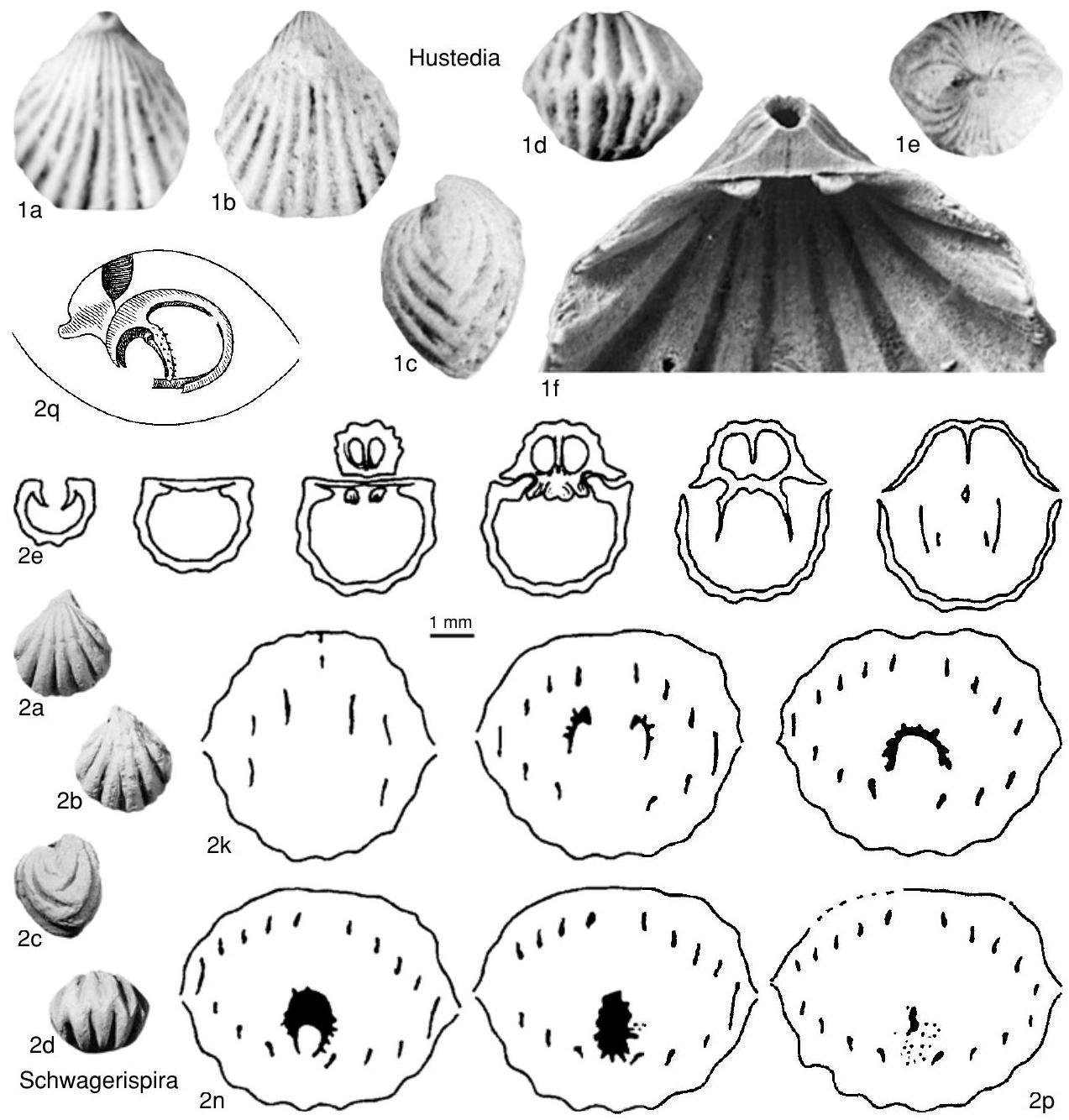Welcome to the Treatise on Invertebrate Paleontology!
Please enter a genera name to retrieve more information.

Hustedia
Classification
Phylum:
Brachiopoda
Subphylum:
Rhynchonelliformea
Class:
Rhynchonellata
Order:
Athyridida
Suborder:
Retziidina
Superfamily:
Retzioidea
Family:
Neoretziidae
Subfamily:
Hustediinae
Formal Genus Name and Reference:
Hustedia Hall & CLARKE, 1893, p. 120
Type Species:
Terebratula mormoni MARCOU, 1858, p. 51, OD
Images
(Click to enlarge in a new window)
Fig. 1087, Ia-e. *H. mormoni (Marcou), Upper Carboniferous, Nebraska, USA, dorsal, ventral, lateral, anterior, and posterior views, USNM 154456, ×4 (Cooper & Grant, 1976b). [See also Fig. 1080–1081, p. 1585–1586, in introduction.]
Synonyms
Geographic Distribution
cosmopolitan
Age Range
Beginning Stage in Treatise Usage:
Carboniferous (Tournaisian)
Beginning International Stage:
Tournaisian
Fraction Up In Beginning Stage:
0
Beginning Date:
359.3
Ending Stage in Treatise Usage:
Permian (Tatarian)
Ending International Stage:
Wuchiapingian
Fraction Up In Ending Stage:
40
Ending Date:
257.43
Description
"Subequally biconvex, elongate-oval, costate shells, commissure strongly plicate and slightly uniplicate, rectimarginate, or sulcate, emarginate, costae simple with same width in median region as in flanks, slightly raised median costa on dorsal valve may be present, symphytium transversely flat, longitudinally gently concave, foramen in submeso- to permesothyridid position, blunt hinge teeth elongate transversely along hinge, pedicle collar short, hinge plate thick, strongly recurved to extend posteriorly along inner face of symphytium, rather short, bladelike crura slightly divergent and directed almost ventrally, short, ligulate process extending forward from base of hinge plate, short median septum in apex beneath hinge plate, extending forward as low median ridge, lateral branches of jugum originating quite posteriorly, projecting anteroventrally as spiny lamellae that join medianly and project posteroventrally in long, sharp, spiny stem."
References
Museum or Author Information
Classification
Phylum:
Brachiopoda
Subphylum:
Rhynchonelliformea
Class:
Rhynchonellata
Order:
Athyridida
Suborder:
Retziidina
Superfamily:
Retzioidea
Family:
Neoretziidae
Subfamily:
Hustediinae
Formal Genus Name and Reference:
Hustedia Hall & CLARKE, 1893, p. 120
Type Species:
Terebratula mormoni MARCOU, 1858, p. 51, OD
Images
(Click to enlarge in a new window)
Fig. 1087, Ia-e. *H. mormoni (Marcou), Upper Carboniferous, Nebraska, USA, dorsal, ventral, lateral, anterior, and posterior views, USNM 154456, ×4 (Cooper & Grant, 1976b). [See also Fig. 1080–1081, p. 1585–1586, in introduction.]
Synonyms
Geographic Distribution
cosmopolitan
Age Range
Beginning Stage in Treatise Usage:
Carboniferous (Tournaisian)
Beginning International Stage:
Tournaisian
Fraction Up In Beginning Stage:
0
Beginning Date:
359.3
Ending Stage in Treatise Usage:
Permian (Tatarian)
Ending International Stage:
Wuchiapingian
Fraction Up In Ending Stage:
40
Ending Date:
257.43
Description
"Subequally biconvex, elongate-oval, costate shells, commissure strongly plicate and slightly uniplicate, rectimarginate, or sulcate, emarginate, costae simple with same width in median region as in flanks, slightly raised median costa on dorsal valve may be present, symphytium transversely flat, longitudinally gently concave, foramen in submeso- to permesothyridid position, blunt hinge teeth elongate transversely along hinge, pedicle collar short, hinge plate thick, strongly recurved to extend posteriorly along inner face of symphytium, rather short, bladelike crura slightly divergent and directed almost ventrally, short, ligulate process extending forward from base of hinge plate, short median septum in apex beneath hinge plate, extending forward as low median ridge, lateral branches of jugum originating quite posteriorly, projecting anteroventrally as spiny lamellae that join medianly and project posteroventrally in long, sharp, spiny stem."
